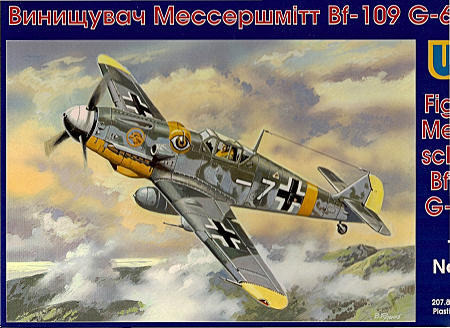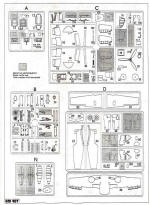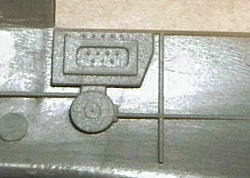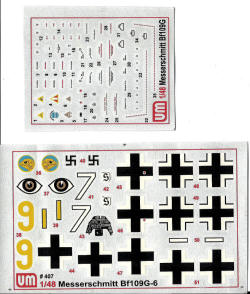
| KIT #: | 407 |
| PRICE: | $32.00 MSRP |
| DECALS: | Two options |
| REVIEWER: | John Doerr |
| NOTES: | 129 parts on 5 sprues; 15 clear on one sprue |

| HISTORY |
What can I possibly add about the history of the Bf 109? There are many books and there are web sites dedicated to the 109 alone. It was the symbol and face of the Luftwaffe. The G series was the ultimate 109, produced in greater numbers and wider variations than any other model.
| THE KIT |
 The
kit comes in the standard tray and lid box.
While the lid is rather thin the tray is made of thick, sturdy card
board. It protects the kit well and
serves very nicely for holding the parts during construction.
The
kit comes in the standard tray and lid box.
While the lid is rather thin the tray is made of thick, sturdy card
board. It protects the kit well and
serves very nicely for holding the parts during construction.
 The moldings
are in a medium light gray, very reminiscent of Airfix. They are
quite soft and have a slightly pebbly texture as, unfortunately, do the clear
parts. A dip in Future seems to have cleared them up nicely. The
moldings are generally flash free, with some minor flash and a few parts that
would be easily cleaned up and quite nicely done with recessed surface detail on
the exterior pieces. The rudder pedals are the best I have seen. The
moldings break down into the universal type, like other kits, to make it
possible to build any version from the basic molds. Unlike the Japanese
releases, this kit contains all the parts necessary to build all of versions of
the G that were equipped with the narrow tires, all in the same box.
The moldings
are in a medium light gray, very reminiscent of Airfix. They are
quite soft and have a slightly pebbly texture as, unfortunately, do the clear
parts. A dip in Future seems to have cleared them up nicely. The
moldings are generally flash free, with some minor flash and a few parts that
would be easily cleaned up and quite nicely done with recessed surface detail on
the exterior pieces. The rudder pedals are the best I have seen. The
moldings break down into the universal type, like other kits, to make it
possible to build any version from the basic molds. Unlike the Japanese
releases, this kit contains all the parts necessary to build all of versions of
the G that were equipped with the narrow tires, all in the same box.
They include the short or tall tail,
rudders and two sets of horizontal stabilizers, the cowlings to do both the
standard and the G-10 or AS versions and two different external tanks. It
has the complete selection of canopies and windshields. It has
everything you need to open up everything in front of the windshield, including
both 7.9 and 13 mm machine guns.
The engine is on a separate sprue, and appears quite detailed.
It is composed of 37 pieces with
two different superchargers, oil
 tanks and engine
bearers. The cockpit appears marginal with the proper seat, but will need
belts. Details are molded to the side walls with the outer trim wheel as a
separate piece, ala the Tamiya E series. The side details are quite skimpy
and would probably best be replaced by a resin aftermarket set. The
instrument panel is molded in clear plastic.
The details are raised but the instruments themselves are simply circles
with no details. There is a decal
for the instrument panel but it is a basic white on black and is applied to and
covers the whole front of the panel.
I would replace this with a better panel from an aftermarket cockpit set.
tanks and engine
bearers. The cockpit appears marginal with the proper seat, but will need
belts. Details are molded to the side walls with the outer trim wheel as a
separate piece, ala the Tamiya E series. The side details are quite skimpy
and would probably best be replaced by a resin aftermarket set. The
instrument panel is molded in clear plastic.
The details are raised but the instruments themselves are simply circles
with no details. There is a decal
for the instrument panel but it is a basic white on black and is applied to and
covers the whole front of the panel.
I would replace this with a better panel from an aftermarket cockpit set.
Sprue A is the
clear parts containing three set of windshields and canopies, two instrument
panels, the armored headrest with inset glass and the navigation lights
Sprue B Contains
all if the engine parts, save one cap for the prop shaft
Sprue C contains the cockpit parts, two set of stabilizers, two rudders and the flaps and slats.
Sprue D is three trees linked together. The wing bottom and top halves are on their own trees tenuously linked to the main tree, which contains the main fuselage parts, two sets of tails and two sets of cowlings. Also on the tree are the wheels and tail wheel.
I am unhappy about
the wheels as they appear generic and the hub moldings lack a clear recessed
boundary to facilitate painting the tire and hub.
The location of the wheels and tail wheel, suggests that if UM does do a
wide tired version then it will also contain only the generic wheels.
It would seem that the appropriate after market wheels would be in order.
Although the instruction make no mention the tail wheel strut is the
longer type but designed to be cut if a the shorter one is wanted length.
The kit is molded with an open tail wheel bay but has a stub and covering
to make the later fixed tail wheels

Sprue N has two different styles of drop tanks.
 The decals
appear to be OK. The decals are for
your choice of two different aircraft both with the 74/75/76 scheme.
You get two small sheets, one with the markings, insignia and instrument
panel and a smaller sheet with the stencils.
They appear to be on register and well printed.
The decals
appear to be OK. The decals are for
your choice of two different aircraft both with the 74/75/76 scheme.
You get two small sheets, one with the markings, insignia and instrument
panel and a smaller sheet with the stencils.
They appear to be on register and well printed.
The instructions are of the international type of mainly drawings. Where text there is supplied in Cyrillic (Russian?), English and German. The high spot is full color profiles of both versions. The color call out are by Humbrol number and name. Unfortunately they don't give the RLM names/numbers. An experienced Luftwaffe modeler will have no problem interpreting the colors. The instructions leave a lot or be desired. In some places they are quite vague and in others just plain wrong, such as placing the supercharger on the wrong side of the engine!
| CONCLUSIONS |
Where I have fitted
the parts they appear to fit quite well, better than most short run kits
The kit is definitely not for novices, mainly due to the poor quality of
the instructions. This is a kit
that relies on the builders knowledge of the version he wants to produce.
As stated earlier there are enough parts in the box to build any version
of the G as long as it had the narrow tires.
This a good cost effective kit priced $6 to $10 less than any of it's
competitors, with the exception of the Revell repop of the old Monogram G-10
| REFERENCES |
http://en.wikipedia.org/wiki/Messerschmitt_Bf_109
Personal communication: Ritger, Lynn
March 2010
If you would like your product reviewed fairly and quickly, please contact me or see other details in the Note to Contributors.